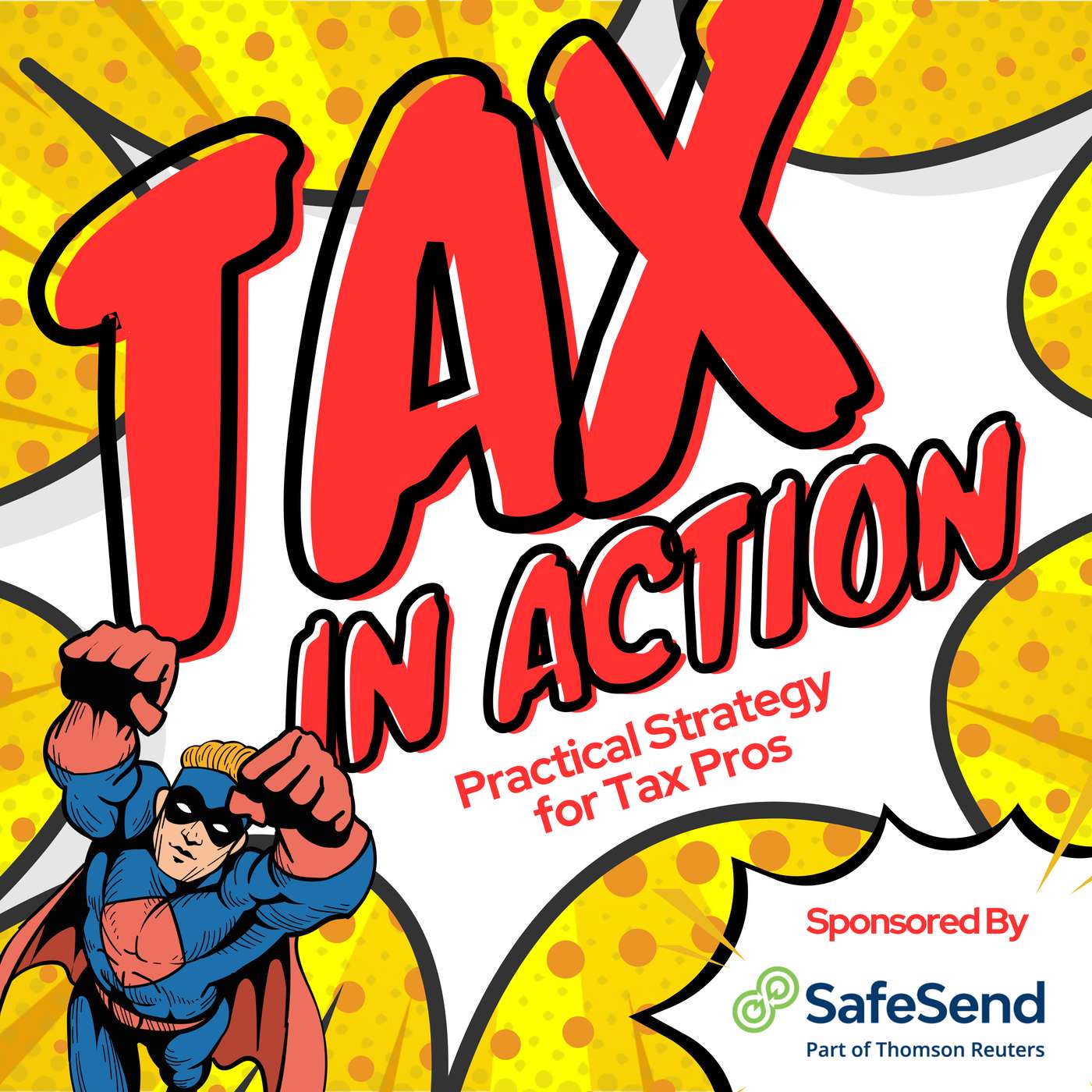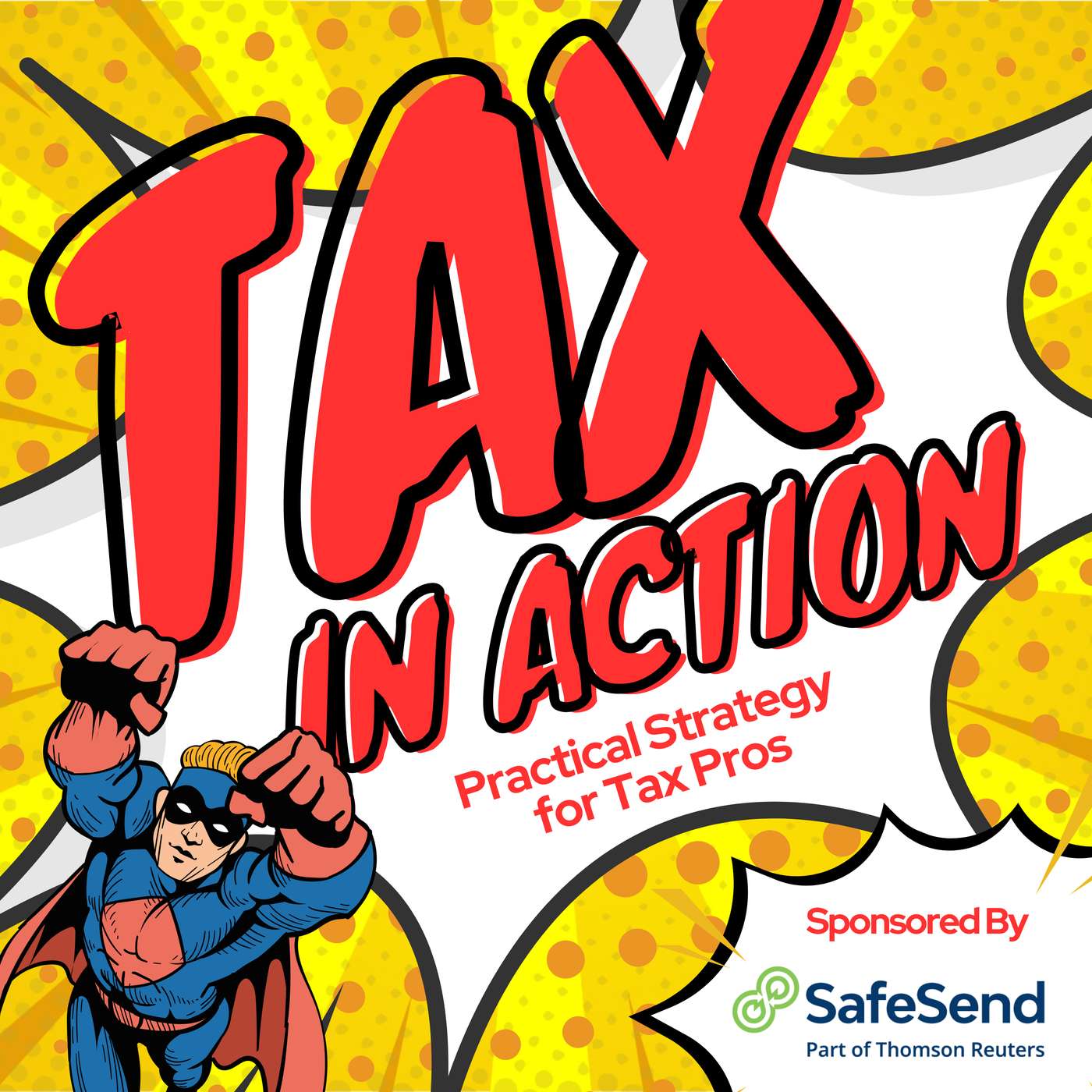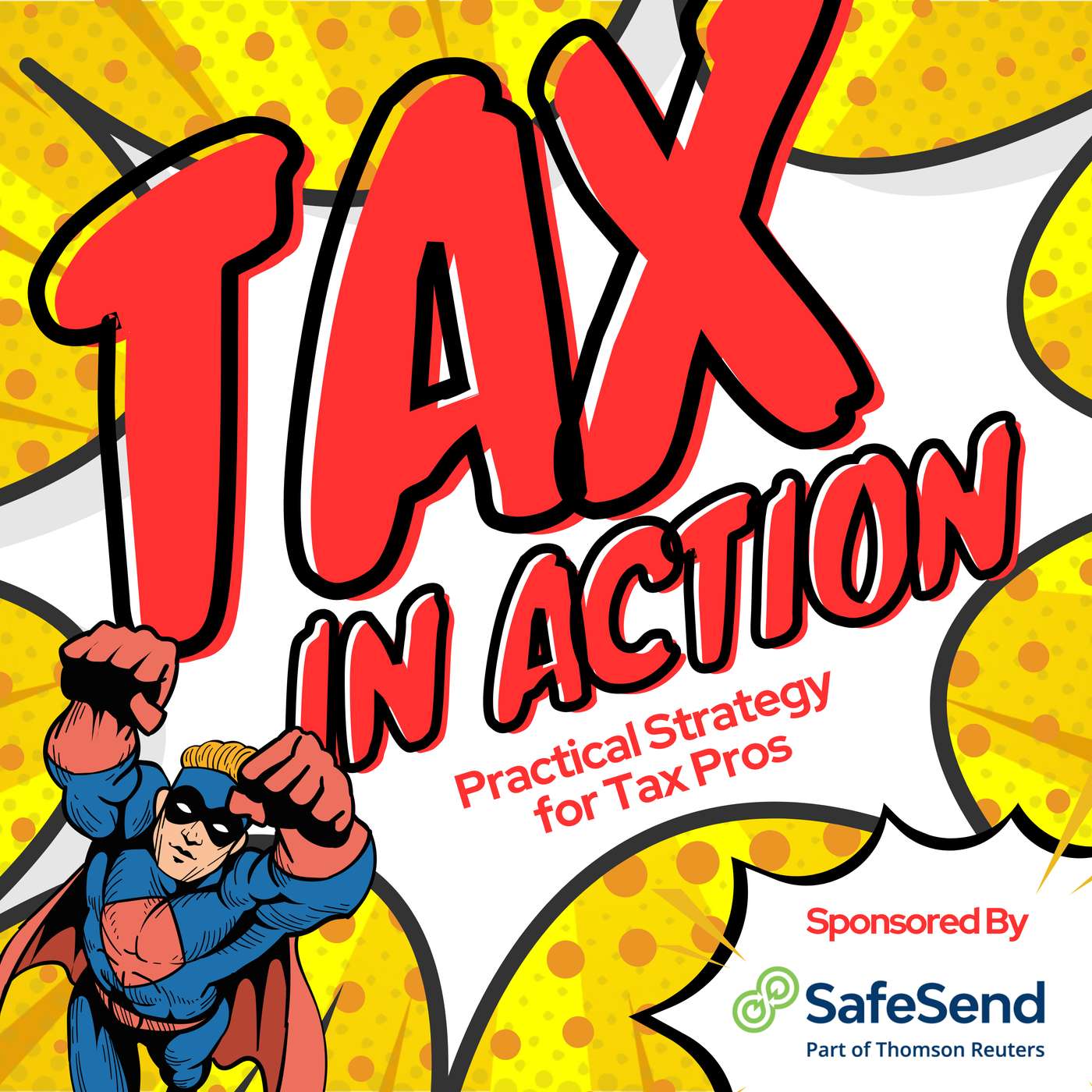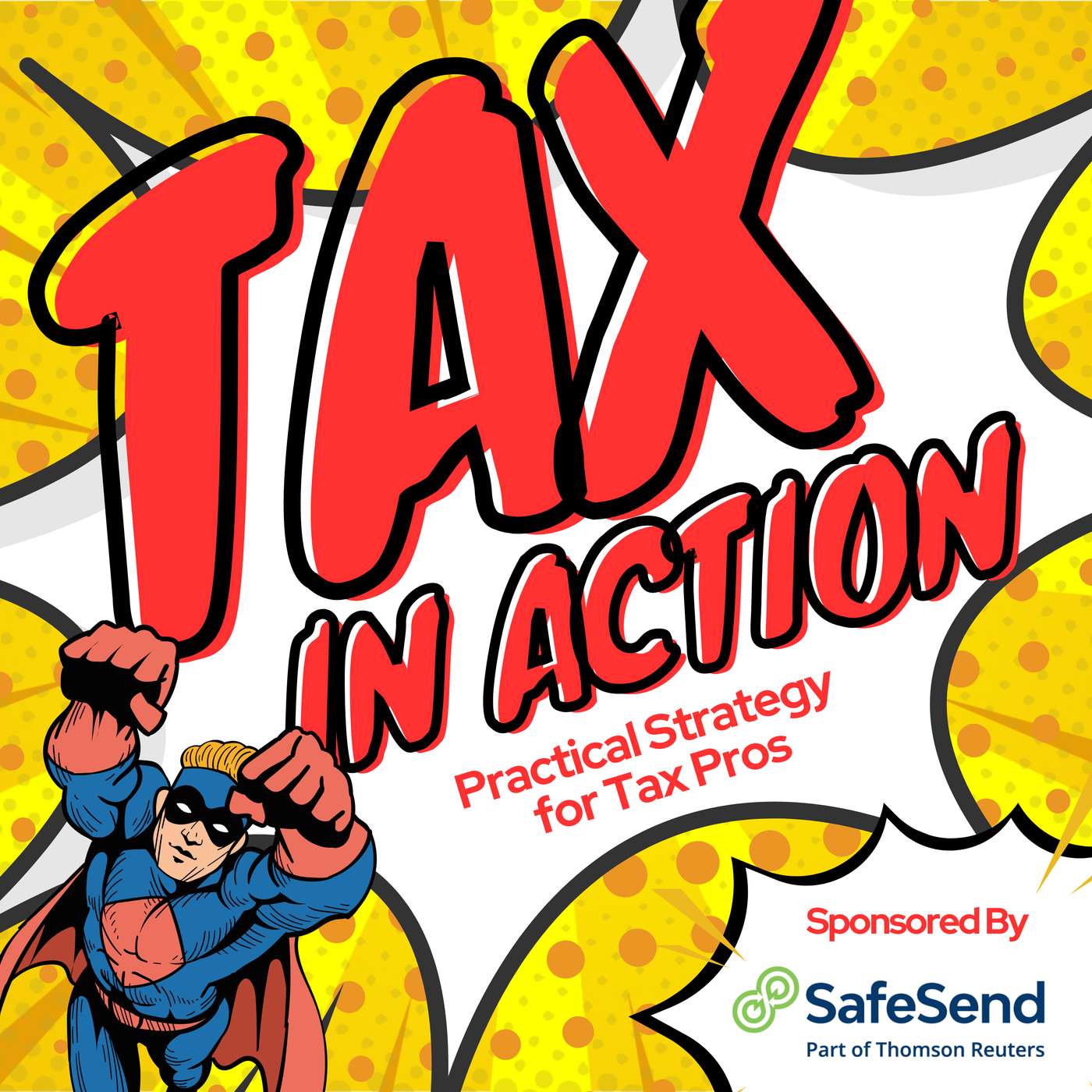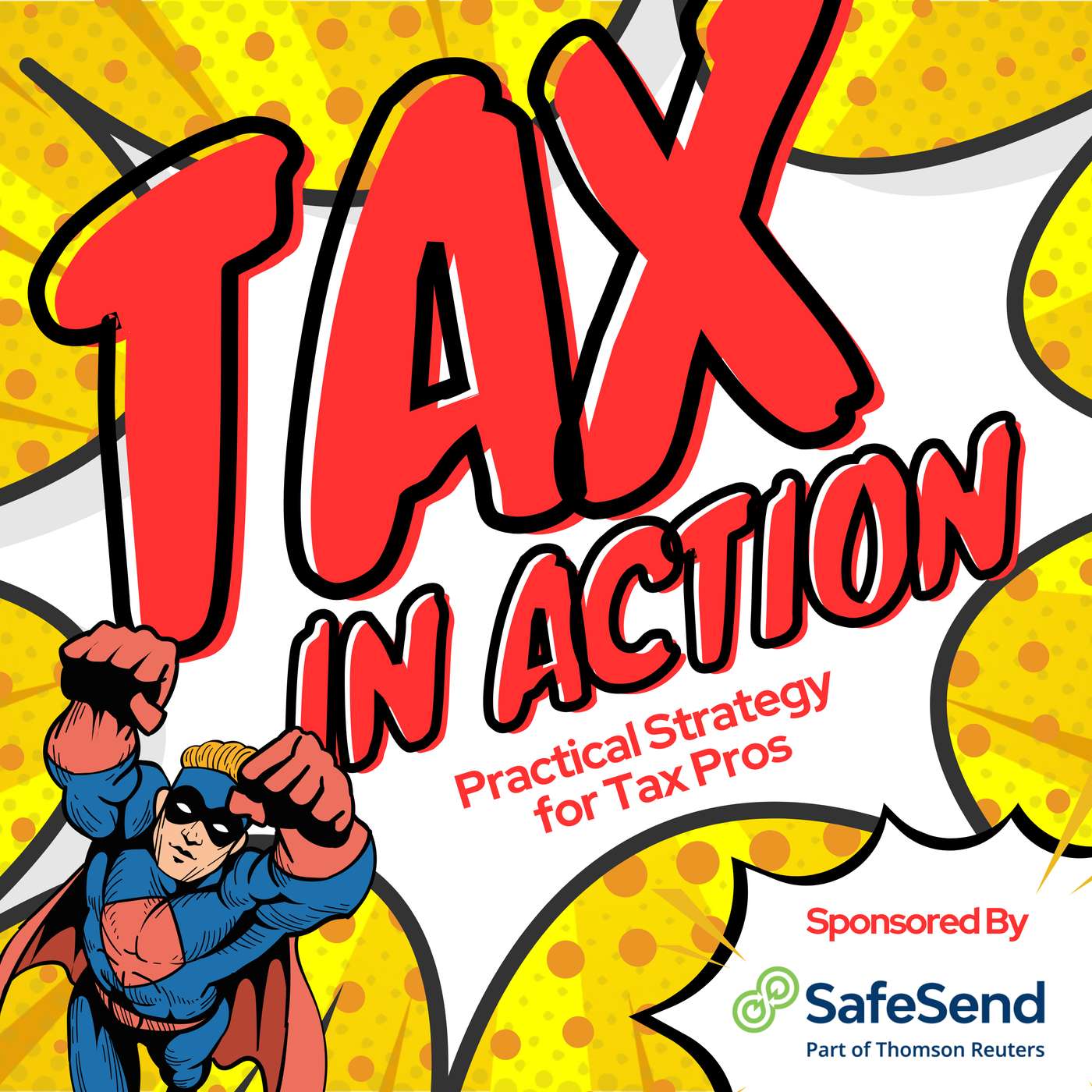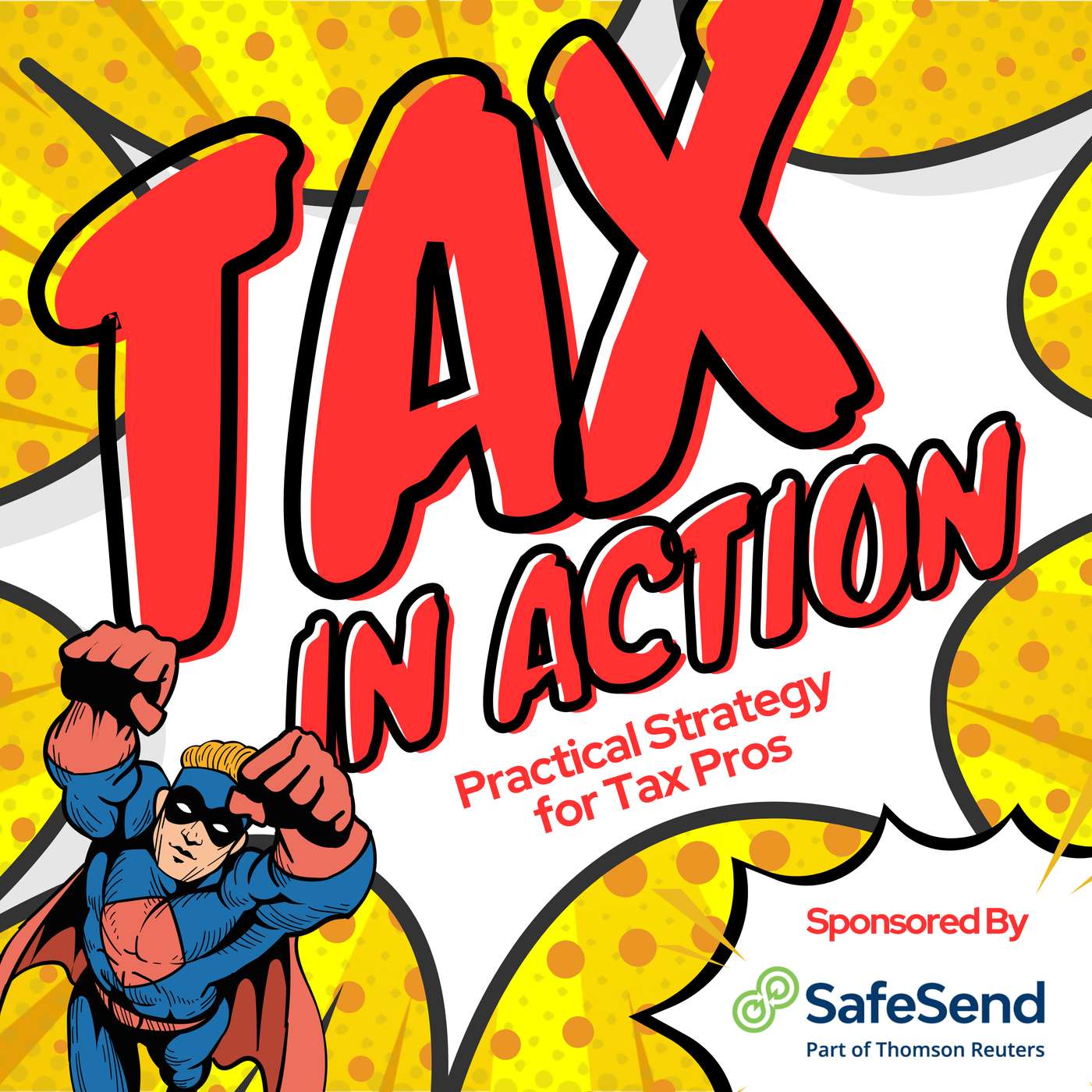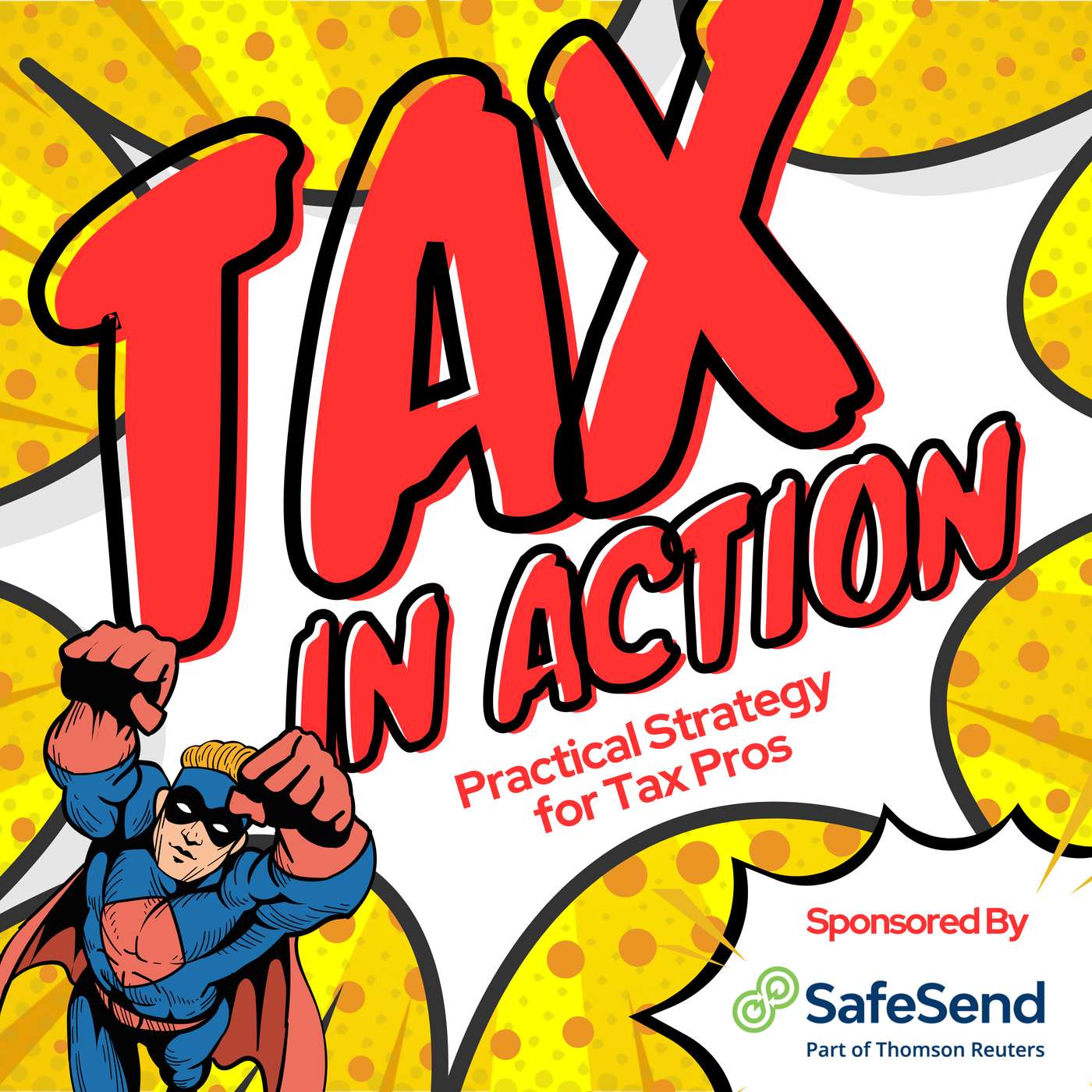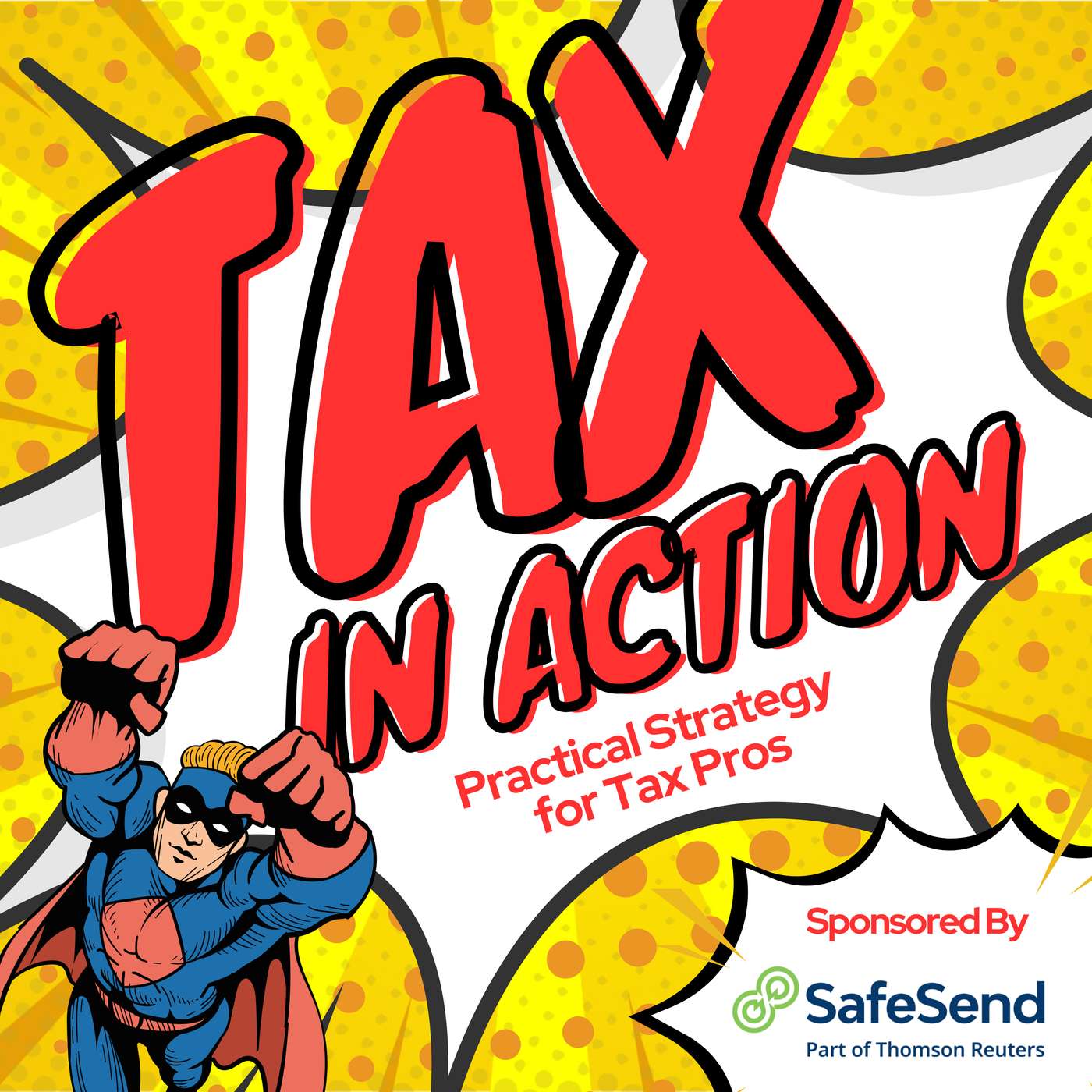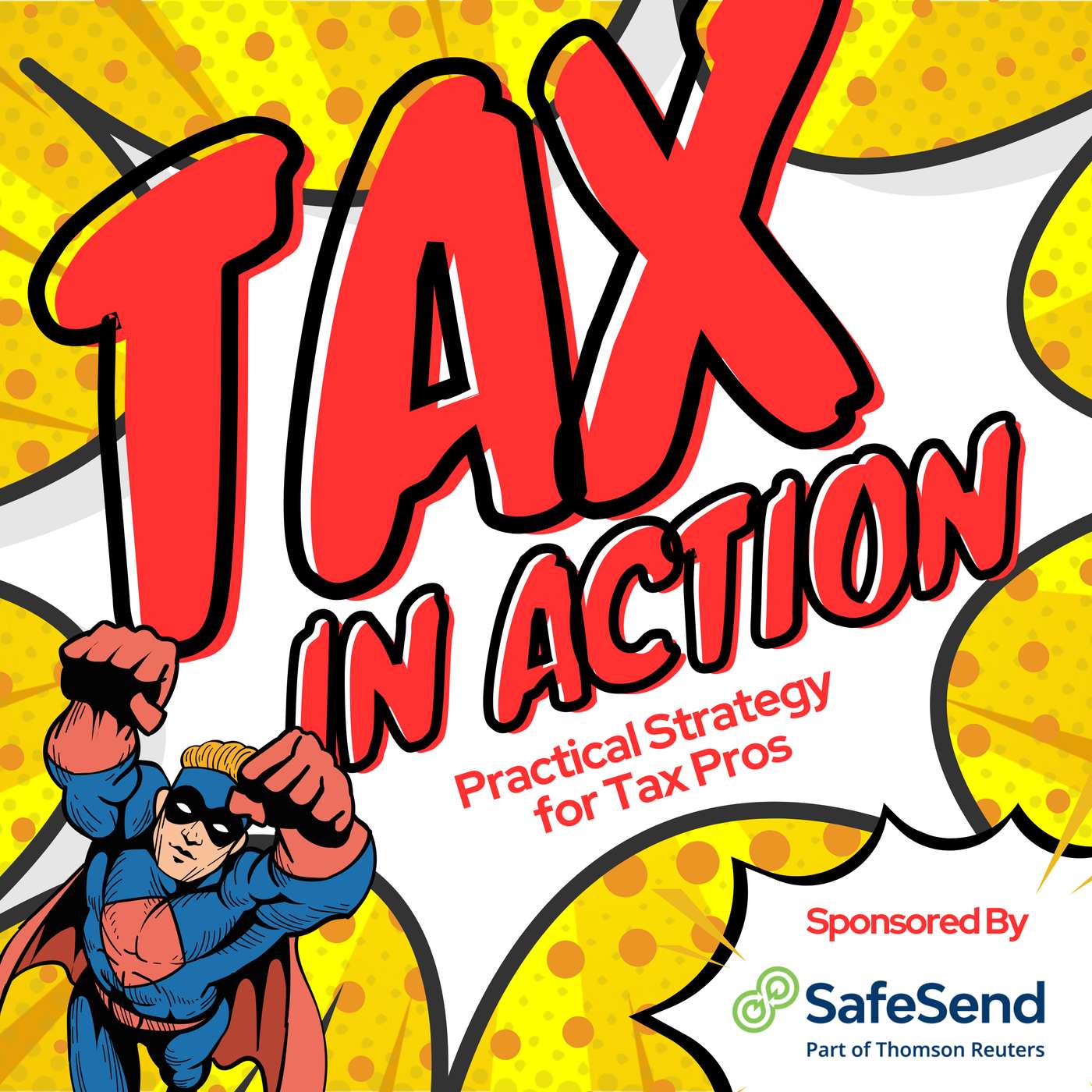Discover Tax in Action: Practical Strategies for Tax Pros
Tax in Action: Practical Strategies for Tax Pros

Tax in Action: Practical Strategies for Tax Pros
Author: Jeremy Wells, EA, CPA
Subscribed: 11Played: 76Subscribe
Share
© 2025 Jeremy Wells, EA, CPA
Description
Join Jeremy Wells, EA, CPA, as he breaks down the complexities of tax law into practical guidance you can apply immediately. Each episode focuses on a specific tax strategy, credit, or compliance issue that matters to tax professionals and business owners. Rather than theoretical discussions, Jeremy delivers actionable insights based on real-world scenarios and current tax regulations. Whether you're navigating Section 1031 exchanges, maximizing research credits, or helping clients with energy tax incentives, this podcast provides the technical details and strategic considerations you need to confidently serve your clients. Perfect for tax practitioners looking to deepen their expertise and business owners wanting to make more informed tax decisions.
16 Episodes
Reverse
Jeremy wraps up his two-part series on S corporation terminations by diving into what happens after an election ends, whether intentional or inadvertent. He explains the IRS's relief procedures for common mistakes like violating the one-class-of-stock rule, the crucial five-year waiting period before re-electing, and why a terminated S corp doesn't just revert back to an LLC but becomes a C corporation instead. The discussion includes real tax court cases and the specific steps needed to clean up termination issues before the IRS discovers them.(00:00) - Introduction and Recap of Part One
(01:40) - Three Ways to Terminate an S Election
(03:30) - Administrative Dissolutions at the State Level
(08:00) - What Happens After S Election Termination
(13:10) - Inadvertent Terminations Explained
(17:00) - The One Class of Stock Rule
(21:30) - Maggard v. Commissioner Tax Court Case
(26:20) - Profit Interests and Phantom Equity Problems
(29:40) - IRS Relief for Inadvertent Terminations
(34:30) - Revenue Procedure 2022-19
(39:20) - Missing S Election Acceptance Letters
(42:00) - Filing the Wrong Return Type
(44:10) - Six Areas of Relief Without a PLR
(47:10) - Short Year Returns and Pro Rata Allocation
(51:30) - The Five-Year Rule Explained
(54:20) - Reverting from C Corp Back to LLC Status
(56:50) - Final Thoughts and Episode Wrap-Up
Connect with Jeremyhttps://www.linkedin.com/in/jwellstaxhttps://www.steadfastbookkeeping.comSubscribe on YouTubehttps://www.youtube.com/@TaxinActionEarn CPE for Listening to This Podcasthttps://www.earmark.app/This podcast is a production of Earmark Media
Jeremy breaks down the three ways an S-corporation election can terminate: voluntary revocation (including the lesser-known withdrawal option from the IRM), ceasing to qualify as a small business corporation, and excessive passive investment income. He walks through the specific mechanics of each termination method, from shareholder consent requirements to the 100-shareholder limit and the one-class-of-stock rule.Connect with Jeremyhttps://www.linkedin.com/in/jwellstaxhttps://www.steadfastbookkeeping.comSubscribe on YouTubehttps://www.youtube.com/@TaxinActionEarn CPE for Listening to This Podcasthttps://www.earmark.app/This podcast is a production of Earmark Media
Jeremy dives into the often-overlooked legal requirements for taxpayer recordkeeping under IRC Section 6001, explaining why accurate books aren't just nice to have: they're mandatory. He breaks down the Cohan rule (and why it's widely misunderstood), explores how good recordkeeping can shift the burden of proof to the IRS under Section 7491, and offers practical ways tax professionals can encourage better client recordkeeping without becoming bookkeepers themselves.SponsorsSafeSend - taxshow.promo/safesend(00:00) - Introduction: The Struggles of Accounting Firms
(01:06) - Challenges with PBC Data
(01:56) - Balancing Bookkeeping and Tax Services
(04:03) - Legal Requirements for Bookkeeping
(04:43) - The Cohan Rule Explained
(10:23) - Penalties for Inadequate Record Keeping
(25:01) - When Cohan Doesn't Apply
(30:06) - Ethical Considerations for Tax Practitioners
(34:39) - Encouraging Better Bookkeeping Practices
(44:12) - Leveraging Technology for Record Keeping
(47:08) - Offering Bookkeeping Review Services
(53:06) - Building a Network of Preferred Partners
(55:52) - Pricing and Providing Additional Services
(01:02:37) - Conclusion: Adding Value Without Extra Work
Connect with Jeremyhttps://www.linkedin.com/in/jwellstaxhttps://www.steadfastbookkeeping.comSubscribe on YouTubehttps://www.youtube.com/@TaxinActionEarn CPE for Listening to This Podcasthttps://www.earmark.app/This podcast is a production of Earmark Media
Jeremy concludes his three-part series on losses by examining IRC Section 1033, the tax code's provision for what happens after you replace property lost to casualty, theft, or government condemnation. When clients receive insurance payouts or condemnation proceeds, they face a critical decision: recognize the gain immediately or defer it by purchasing qualifying replacement property within specific timeframes. Jeremy breaks down the "similar use" requirements, the two to four year replacement periods depending on property type, and how basis carries over to help clients avoid unexpected tax bills when bad things force them to start over.SponsorsSafeSend - taxshow.promo/safesend(00:00) - Welcome to Tax in Action
(00:19) - Recap of Previous Episodes
(00:53) - Involuntary Conversions Explained
(04:06) - Case Study: Jessica's Print Shop
(05:41) - Defining Involuntary Conversions
(07:01) - Government Seizures and Condemnations
(07:36) - Court Cases and Legal Precedents
(20:27) - Replacement Property Rules
(35:10) - Special Rules for Principal Residences
(50:11) - State Tax Law Considerations
(54:09) - Conclusion and Final Thoughts
Connect with Jeremyhttps://www.linkedin.com/in/jwellstaxhttps://www.steadfastbookkeeping.comSubscribe on YouTubehttps://www.youtube.com/@TaxinActionEarn CPE for Listening to This Podcasthttps://www.earmark.app/This podcast is a production of the Earmark Media
Jeremy explores the complex world of theft loss deductions, examining how digital asset scams have renewed interest in these tax provisions under the Tax Cuts and Jobs Act. The episode breaks down the three key criteria for claiming theft losses, explains why timing of discovery matters more than when the theft occurred, and analyzes five modern scam scenarios from IRS Chief Counsel guidance including pig butchering schemes and romance scams. Jeremy concludes with a fascinating 1984 court case involving Civil War veterans' land rights that shows even tax court judges can disagree on fundamental questions of tax law.SponsorsSafeSend - taxshow.promo/safesend(00:00) - Introduction: Digital assets spark new interest in theft losses
(03:00) - The three types of losses under IRC Section 165
(08:00) - Three criteria for claiming a theft loss deduction
(13:00) - When discovery matters more than when theft occurred
(19:00) - State law defines theft for federal tax purposes
(25:35) - Simple disappearance is not theft
(28:35) - Casualty losses vs theft losses: Key differences
(30:35) - Stock declines don't qualify as theft losses
(34:35) - Ponzi schemes get special safe harbor treatment
(42:35) - Five modern scam scenarios from IRS Chief Counsel
(54:35) - Reporting theft losses on Form 4684
(57:35) - The Booth case: When smart judges disagree
(01:03:35) - Wrap-up and final thoughts
Connect with Jeremyhttps://www.linkedin.com/in/jwellstaxhttps://www.steadfastbookkeeping.comSubscribe on YouTubehttps://www.youtube.com/@TaxinActionEarn CPE for Listening to This Podcasthttps://www.earmark.app/This podcast is a production of the Earmark Media
Natural disasters, accidents, and sudden destructive events can create significant financial hardship, but the tax code provides some relief through casualty loss deductions. This episode breaks down the complex rules governing what qualifies as a deductible casualty loss, including the critical distinction between personal and business losses under the Tax Cuts and Jobs Act. Jeremy walks through the three-part test for casualty losses, calculation methods using fair market value changes, and the reporting requirements on Form 4684, using a real-world hurricane damage scenario to illustrate these concepts.SponsorsSafeSend - taxshow.promo/safesend(00:00) - Introduction to the Series
(01:08) - Understanding Casualty Losses
(02:57) - Case Study: Jessica's Print Shop
(05:16) - Types of Casualty Losses
(06:57) - Tax Cuts and Jobs Act Impact
(12:22) - Determining Deductible Casualty Losses
(18:36) - An Identifiable Event
(27:09) - Determining Casualty Loses or Gains
(32:04) - Filing an Insurance Claim
(41:19) - Reporting Casualty Losses
(50:51) - What to Do For Casualty Gain
(57:21) - Conclusion and Recap
Connect with Jeremyhttps://www.linkedin.com/in/jwellstaxhttps://www.steadfastbookkeeping.comSubscribe on YouTubehttps://www.youtube.com/@TaxinActionEarn CPE for Listening to This Podcasthttps://www.earmark.app/This podcast is a production of the Earmark Media
Jeremy breaks down the complex rules surrounding Section 121's capital gains exclusion for home sales, using the Weber v. Commissioner tax court case to illustrate how taxpayers can lose out on excluding up to $500,000 in gains. The episode covers the critical two-out-of-five year ownership and use tests, explains how rental conversions can disqualify you from the exclusion, and details the partial exclusion exceptions for employment changes, health issues, and unforeseen circumstances. Understanding these nuances is essential since home sales often represent the largest financial transactions in taxpayers' lives.SponsorsSafeSend - taxshow.promo/safesend(00:00) - Section 121
(01:05) - Capital Gain Exclusion Introduction
(03:21) - Case Study: Webert vs Commissioner
(05:51) - Defining Principal Residence
(15:58) - Ownership and Use Tests
(27:43) - Understanding Spousal Eligibility for Exclusion
(28:51) - Principal Residence Usage Requirements
(30:52) - Counting Days and Periods of Absence
(32:36) - Special Considerations for Older Taxpayers
(33:57) - Ownership Through Trusts and LLCs
(36:57) - The Once Every Two Years Rule
(41:10) - Non-Qualified Use Explained
(47:06) - Case Study: The Webers' Tax Court Case
(48:12) - Partial Exclusions and Safe Harbors
(56:51) - Conclusion and Key Takeaways
Connect with Jeremyhttps://www.linkedin.com/in/jwellstaxhttps://www.steadfastbookkeeping.comSubscribe on YouTubehttps://www.youtube.com/@TaxinActionEarn CPE for Listening to This Podcasthttps://www.earmark.app/This podcast is a production of the Earmark Media
A rental property owner faces a $27,000 repair bill after a plumbing leak forces a complete bathroom renovation, water heater replacement, and structural repairs. Jeremy breaks down Treasury Decision 9636's framework for distinguishing between deductible repairs and capitalized improvements, using the three-part test of betterment, restoration, and adaptation. He also explains three valuable safe harbors including the de minimis election and routine maintenance provisions that can help property owners expense more costs immediately rather than depreciating them over time.SponsorsSafeSend - taxshow.promo/safesend(00:00) - Introduction to Repairs vs. Improvements
(00:44) - Understanding the Basics of Repairs and Improvements
(01:42) - Real Estate and Vehicle Examples
(04:30) - IRS Guidelines and Treasury Decision 96-36
(06:53) - Case Study: Rental Property Repairs
(18:39) - Determining Repairs vs. Improvements
(39:05) - Safe Harbors for Taxpayers
(55:57) - Conclusion and Key Takeaways
Connect with Jeremyhttps://www.linkedin.com/in/jwellstaxhttps://www.steadfastbookkeeping.comSubscribe on YouTubehttps://www.youtube.com/@TaxinActionEarn CPE for Listening to This Podcasthttps://www.earmark.app/This podcast is a production of the Earmark Media
Jeremy breaks down the complex world of work-related education tax benefits, revealing why most educational expenses aren't as deductible as business owners think. He explains the stark difference between limited educational assistance programs that cap benefits at $5,250 annually and business expense deductions that often get rejected by the IRS for qualifying taxpayers for "new trades or businesses." Through real tax court cases involving everyone from IRS agents trying to deduct law school to nurses upgrading their licenses, this episode exposes the narrow window where education costs actually qualify as legitimate business deductions.SponsorsSafeSend - taxshow.promo/safesend(00:00) - Introduction: The Knowledge Economy
(01:00) - General Education Tax Benefits
(04:20) - Business Owner Education Questions
(05:20) - Two Main Approaches for Business Education Benefits
(08:20) - Educational Assistance Programs Deep Dive
(14:20) - Program Limitations and Restrictions
(23:55) - What Educational Assistance Programs Cover
(28:15) - Substantiation and Double Benefit Rules
(31:55) - Business Expense Deduction Alternative
(34:35) - Qualifying Education Expenses
(39:15) - Non-Deductible Education: Two Key Exceptions
(42:35) - Established in Trade or Business Requirement
(45:55) - Law Degrees and New Trade or Business
(49:35) - Professional Certifications as New Trade or Business
(51:15) - MBA Programs: Split Tax Court Decisions
(54:15) - Final Warnings and Best Practices
Connect with Jeremyhttps://www.linkedin.com/in/jwellstaxhttps://www.steadfastbookkeeping.comSubscribe on YouTubehttps://www.youtube.com/@TaxinActionEarn CPE for Listening to This Podcasthttps://www.earmark.app/This podcast is a production of the Earmark Media
Understanding the refund statute of limitations can mean the difference between claiming a refund and losing that money forever. This episode breaks down the complex rules around when taxpayers can file refund claims and how much they can recover, using the recent Hamilton v. US case as a cautionary tale. Whether you're dealing with late-filed returns, amended returns, or clients who've fallen behind on their taxes, these statute of limitations rules will determine what's possible and what's permanently lost.SponsorsSafeSend - taxshow.promo/safesend(00:00) - Welcome to Tax in Action
(01:50) - Understanding Finality in Tax Code
(03:28) - Assessment vs. Refund Statute of Limitations
(04:11) - Challenges and Misunderstandings
(07:37) - Case Study: Hamilton v. US
(13:09) - Key Tax Code Sections
(17:21) - When Can a Taxpayer Claim a Refund
(33:21) - Estimated Payments
(34:52) - Special Considerations and Exceptions
(54:17) - Conclusion and Key Takeaways
Connect with Jeremyhttps://www.linkedin.com/in/jwellstaxhttps://www.steadfastbookkeeping.comSubscribe on YouTubehttps://www.youtube.com/@TaxinActionEarn CPE for Listening to This Podcasthttps://www.earmark.app/This podcast is a production of the Earmark Media
Most tax professionals assume joint filing is the default for married couples, but the tax code actually says the opposite. Jeremy Wells explores the surprising reality that married filing separately is technically the default status, requiring both spouses to elect joint filing under IRC Section 6013. He breaks down the key disadvantages of separate returns—from reduced credits to income limitations—while explaining legitimate scenarios where paying extra tax through separate filing can lead to better overall financial outcomes, particularly with student loan repayment strategies.SponsorsSafeSend - taxshow.promo/safesend(00:00) - Welcome to Tax in Action
(01:03) - Default Filing Status for Married Couples
(02:42) - Misinterpretations of Joint Filing
(06:30) - Exceptions and Special Cases
(11:00) - Why Joint Returns Have Become the Default for Married Couples
(22:43) - Disadvantages of Filing Separately
(32:04) - Loss of Available Credits
(46:22) - Reasons to Consider Filing Separately
(54:55) - Common Myths and Misunderstandings
(57:49) - Exceptions to Irrevocable Joint Filing
(01:01:24) - Conclusion and Final Thoughts
Connect with Jeremyhttps://www.linkedin.com/in/jwellstaxhttps://www.steadfastbookkeeping.comSubscribe on YouTubehttps://www.youtube.com/@TaxinActionEarn CPE for Listening to This Podcasthttps://www.earmark.app/This podcast is a production of the Earmark Media
Jeremy Wells breaks down the fundamentals of Section 1031 exchanges, explaining how real estate investors can defer capital gains taxes by swapping properties rather than selling and buying separately. He clarifies common misconceptions about these transactions, walks through the strict timing requirements including the 45-day identification and 180-day completion rules, and examines court cases that reveal when the IRS challenges whether replacement properties were truly intended for investment purposes. The discussion covers qualifying property types, disqualified persons, and the practical mechanics of using qualified intermediaries to facilitate these tax-advantaged exchanges.SponsorsSafeSend - taxshow.promo/safesend(00:00) - Introduction to 1031 Exchanges
(02:06) - Understanding the Basics of 1031 Exchanges
(04:15) - Mechanics of a 1031 Exchange
(08:22) - Qualifying Property for 1031 Exchanges
(19:24) - Case Studies: Real-Life 1031 Exchange Scenarios
(29:17) - Taxpayer's Genuine Effort to Rent Property
(30:47) - Disqualified Persons in Section 1031 Exchanges
(34:03) - Understanding Like-Kind Property
(43:55) - Deferred Like-Kind Exchanges
(51:48) - Reporting Like-Kind Exchanges on Form 8824
(56:26) - Conclusion and Final Thoughts
Connect with Jeremyhttps://www.linkedin.com/in/jwellstaxhttps://www.steadfastbookkeeping.comSubscribe on YouTubehttps://www.youtube.com/@TaxinActionEarn CPE for Listening to This Podcasthttps://www.earmark.app/This podcast is a production of the Earmark Media
Jeremy dives deep into the critical red flags that should make tax professionals pump the brakes on S-corporation elections. From balance sheet debt ratios that could trigger unexpected taxable events to operating agreement provisions that can inadvertently terminate S-elections, this episode challenges the "default to S-corp" mentality that's become prevalent in tax advisory circles. Jeremy breaks down the specific scenarios where partnerships or sole proprietorships actually serve business owners better than the often-hyped S-corporation structure.SponsorsSafeSend - taxshow.promo/safesendConnect with Jeremyhttps://www.linkedin.com/in/jwellstaxhttps://www.steadfastbookkeeping.comSubscribe on YouTubehttps://www.youtube.com/@TaxinActionEarn CPE for Listening to This Podcasthttps://www.earmark.app/This podcast is a production of the Earmark Media
The R&D tax credit offers significant tax-saving potential, yet remains misunderstood by many small business owners and their advisors. Jeremy breaks down the key components of the Section 41 credit, explaining qualified research activities, eligible expenses, and calculation methods. Small service-based businesses might qualify more often than they realize, especially when research activities relate to technological innovation, computer science, or engineering processes.SponsorsSafeSend - taxshow.promo/safesend(00:00) - Introduction to the R&D Credit
(03:00) - Components of the R&D Credit
(06:00) - Defining Qualified Research
(13:00) - Business Components and the Shrinking Back Rule
(21:35) - Non-Qualifying Research Activities
(25:35) - Internal Software and the High Threshold of Innovation Test
(30:35) - Calculating the R&D Credit
(33:35) - Qualifying Wages and Expenses
(39:35) - Contract Research Expenses
(44:35) - Credit Calculation Methods
(50:35) - Payroll Tax Election for Startups
(52:35) - Interaction with IRC Section 174
(54:35) - Special Rules for Partnerships
(57:35) - Common Myths and Final Thoughts
Connect with Jeremyhttps://www.linkedin.com/in/jwellstaxhttps://www.steadfastbookkeeping.comSubscribe on YouTubehttps://www.youtube.com/@TaxinActionEarn CPE for Listening to This Podcasthttps://www.earmark.app/This podcast is a production of the Earmark Media
Solar installations create valuable tax benefits, but determining eligible expenses requires careful analysis. Jeremy Wells breaks down the Residential Clean Energy Credit under IRC Section 25D, explaining which costs qualify, how to handle roof modifications, and when the credit can be claimed. The episode provides essential guidance for tax professionals encountering clean energy improvements on client properties.SponsorsSafeSend - taxshow.promo/safesend(00:00) - Welcome to Tax in Action
(00:24) - Client's Solar Panel Installation Scenario
(01:54) - Understanding the Solar Tax Credit
(05:22) - Qualifying Properties and Expenses
(12:43) - Business Use and Allocation at Residence
(16:48) - Calculating Qualifying Expenditures
(38:18) - Timing and Reporting the Credit
(43:58) - Summary and Final Thoughts
(52:11) - Conclusion and Next Steps
Connect with Jeremy https://www.linkedin.com/in/jwellstaxhttps://www.steadfastbookkeeping.comSubscribe on YouTubehttps://www.youtube.com/@TaxinActionEarn CPE for Listening to This Podcast https://www.earmark.app/This podcast is a production of the Earmark Media

